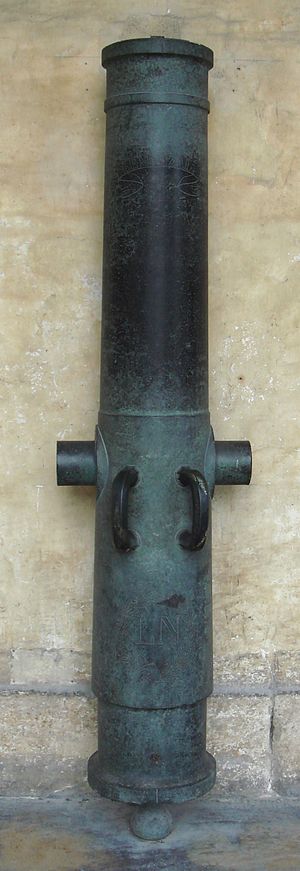- Obusier de 15 cm Valée
-
Obusier de 15 cm Valée 
Obusier de 15 cm Valée, Le Mouzaia, modèle 1828, founded in 1852 in Douai. Les InvalidesPlace of origin France Service history Used by France Production history Designer Sylvain Charles Valée Designed 1828 Specifications Weight 587 kg Barrel length 1.71 m Shell shell within sabot, 7.7 kg Caliber 151 mm Barrels 1 The Obusier de 15 cm Valée, was a French Artillery 6-inches howitzer belonging to the Valée system (French:"Système Valée") of artillery developed between 1825 to 1831 by the French artillery officer Sylvain Charles Valée.[1]
Specifications
The Valée system consisted in various technical improvements to the Gribeauval system. The system mainly improved the mobility of the artillery train, and simplified maintenance by standardizing limber usage and wheel size, and reducing the number of carriage types to two.[1] It also allowed for cannoniers to be able to sit on the ammunition chests of the battery itself during transportation, allowing the whole artillery train to move as fast as the infantry or cavalry.[1]
Valée also improved the guns themselves slightly, by making them lighter, and with a longer range.[2]
The complete Valée system consisted in siege guns of 24 and 16 inches, and field guns of 12 and 8 inches. It also included field howitzers of 24 and 6 inches, and a siege howitzer of 8 inches. Mountain artillery pieces were of 12 inches caliber. Mortars were of 12, 10 and 8 inches, with a 15 inches stone mortar.[1]
Deployment
French artillery would be reorganized along the Valee system in 1827.[3] The "Valée system" would be used at the Capture of Alger (1830) and the Fall of Constantine (1837), as well as during the Crimea War (1853-1856).
An American version of the Valee system was also developed. Some pieces are visible at the Concord Battery, Concord, Massachusetts.[4]
Notes
- ^ a b c d Elements of Military Art and History by Nicolas Édouard Delabarre-Duparcq, p.146-147 [1]
- ^ Systeme An XI and the re-design of the French Artillery. by Paul L Dawson BSc Hons FINS [2]
- ^ Napoleon's Artillery Legacies: France, 1815-1914 - Page 69 by Kenneth N. Jassie
- ^ US Field Gun Carriages—Their History and Evolution by Matthew C. Switlik [3]
Canon de 16 cm · Canon de 8 · Obusier de 60 cm · Obusier de 15 cm · Obusier de 12 cm Categories:
Categories:- Artillery of France
Wikimedia Foundation. 2010.
